Solar eclipse of July 11, 1991
A total solar eclipse occurred on July 11, 1991. A solar eclipse occurs when the Moon passes between Earth and the Sun, thereby totally or partly obscuring the image of the Sun for a viewer on Earth. A total solar eclipse occurs when the Moon's apparent diameter is larger than the Sun's, blocking all direct sunlight, turning day into darkness. Totality occurs in a narrow path across Earth's surface, with the partial solar eclipse visible over a surrounding region thousands of kilometres wide. Totality began over the Pacific Ocean and Hawaii moving across Mexico, down through Central America and across South America ending over Brazil. It lasted for 6 minutes and 53.08 seconds at the point of maximum eclipse. There will not be a longer total eclipse until June 13, 2132. This was the largest total solar eclipse of Solar Saros series 136, because eclipse magnitude was 1.07997.
| Solar eclipse of July 11, 1991 | |
|---|---|
 Totality from Playas del Coco, Costa Rica | |
 Map | |
| Type of eclipse | |
| Nature | Total |
| Gamma | -0.0041 |
| Magnitude | 1.08 |
| Maximum eclipse | |
| Duration | 413 sec (6 m 53 s) |
| Coordinates | 22°N 105.2°W |
| Max. width of band | 258 km (160 mi) |
| Times (UTC) | |
| (P1) Partial begin | 16:28:46 |
| (U1) Total begin | 17:21:41 |
| Greatest eclipse | 19:07:01 |
| (U4) Total end | 20:50:28 |
| (P4) Partial end | 21:43:24 |
| References | |
| Saros | 136 (36 of 71) |
| Catalog # (SE5000) | 9489 |
This eclipse was the most central total eclipse in 800 years, with a gamma of -.0041. There will not be a more central eclipse for another 800 years. Its magnitude was also greater than any eclipse since the 6th century.
Observations
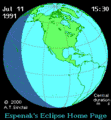 Animation of eclipse path
Animation of eclipse path
 Partial phase before totality as seen through the cloud cover, Playas del Coco, Guanacaste, Costa Rica
Partial phase before totality as seen through the cloud cover, Playas del Coco, Guanacaste, Costa Rica
Related eclipses
Eclipses of 1991
Solar eclipses 1990–1992
This eclipse is a member of a semester series. An eclipse in a semester series of solar eclipses repeats approximately every 177 days and 4 hours (a semester) at alternating nodes of the Moon's orbit.[1] This semester series contains only 7 eclipses.
| Solar eclipse series sets from 1990–1992 | ||||||
|---|---|---|---|---|---|---|
| Ascending node | Descending node | |||||
| Saros | Map | Gamma | Saros | Map | Gamma | |
| 111 | 1989 February 6 | -1.56550 | 116 | 1989 August 1 | 1.58396 | |
| 121 | 1990 January 26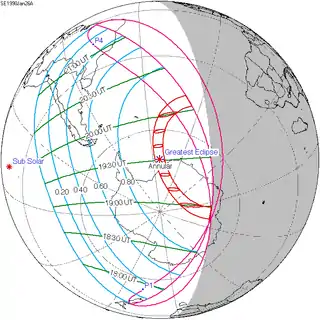 Annular | -0.94571 | 126 | 1990 July 22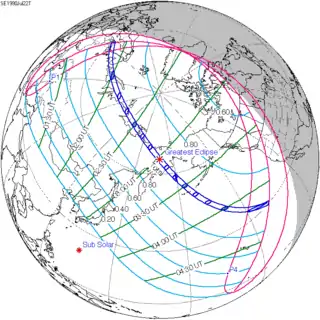 Total | 0.75972 | |
| 131 | 1991 January 15 Annular | -0.27275 | 136 From Playas del Coco | 1991 July 11 Total | -0.00412 | |
| 141 | 1992 January 4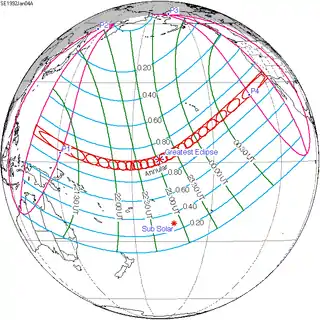 Annular | 0.40908 | 146 | 1992 June 30 Total | -0.75120 | |
| 151 | 1992 December 24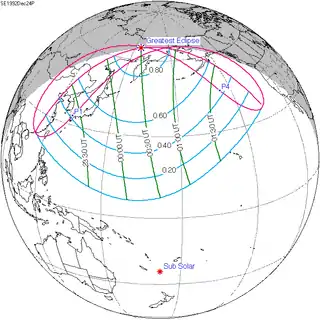 Partial | 1.07106 | 156 | 1993 June 20 | -1.56439 | |
This eclipse is the center of seven central solar eclipses.
Saros 136
Solar Saros 136, repeating every 18 years, 11 days, contains 71 events. The series started with partial solar eclipse on June 14, 1360, and reached a first annular eclipse on September 8, 1504. It was a hybrid event from November 22, 1612, through January 17, 1703, and total eclipses from January 27, 1721 through May 13, 2496. The series ends at member 71 as a partial eclipse on July 30, 2622, with the entire series lasting 1262 years. The longest eclipse occurred on June 20, 1955, with a maximum duration of totality at 7 minutes, 7.74 seconds. All eclipses in this series occurs at the Moon’s descending node.[2]
| Series members 29–43 occur between 1865 and 2117 | ||
|---|---|---|
| 29 | 30 | 31 |
 Apr 25, 1865 |
 May 6, 1883 |
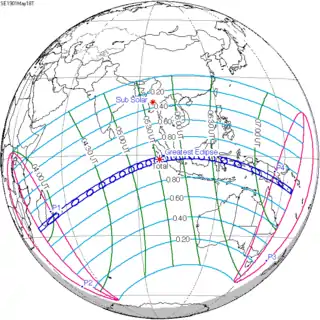 May 18, 1901 |
| 32 | 33 | 34 |
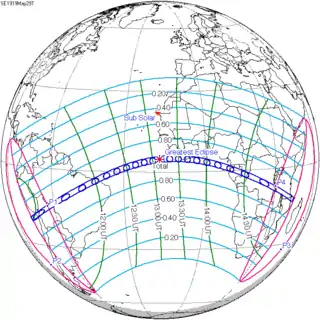 May 29, 1919 |
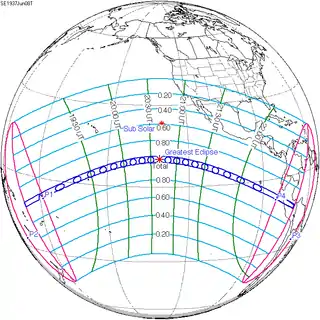 Jun 8, 1937 |
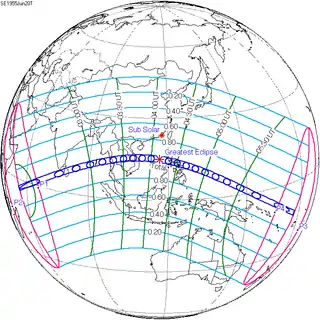 Jun 20, 1955 |
| 35 | 36 | 37 |
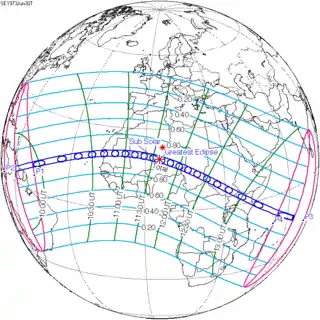 Jun 30, 1973 |
 Jul 11, 1991 |
 Jul 22, 2009 |
| 38 | 39 | 40 |
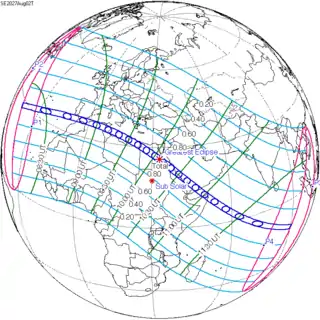 Aug 2, 2027 |
 Aug 12, 2045 |
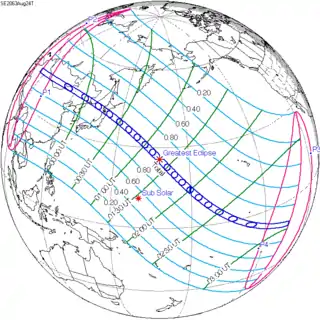 Aug 24, 2063 |
| 41 | 42 | 43 |
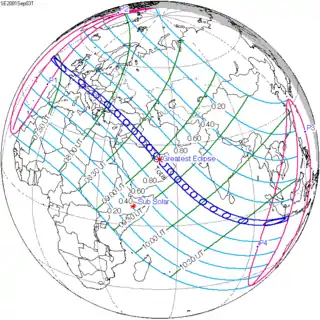 Sep 3, 2081 |
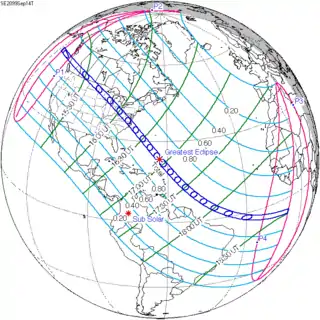 Sep 14, 2099 |
 Sep 26, 2117 |
Inex series
This eclipse is a part of the long period inex cycle, repeating at alternating nodes, every 358 synodic months (≈ 10,571.95 days, or 29 years minus 20 days). Their appearance and longitude are irregular due to a lack of synchronization with the anomalistic month (period of perigee). However, groupings of 3 inex cycles (≈ 87 years minus 2 months) comes close (≈ 1,151.02 anomalistic months), so eclipses are similar in these groupings. In the 18th century:
- Solar Saros 127: Total Solar Eclipse of 1731 Jan 08
- Solar Saros 128: Annular Solar Eclipse of 1759 Dec 19
- Solar Saros 129: Annular Solar Eclipse of 1788 Nov 27
| Inex series members between 1801 and 2200: | ||
|---|---|---|
| Near lunar perigee | After lunar apogee Before lunar perigee |
Before lunar apogee After lunar perigee |
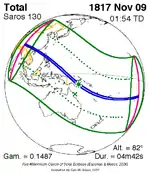 November 9, 1817 (Saros 130) |
 October 20, 1846 (Saros 131) |
 September 29, 1875 (Saros 132) |
 September 9, 1904 (Saros 133) |
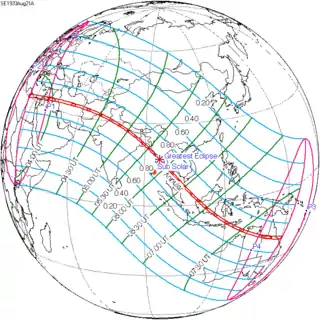 August 21, 1933 (Saros 134) |
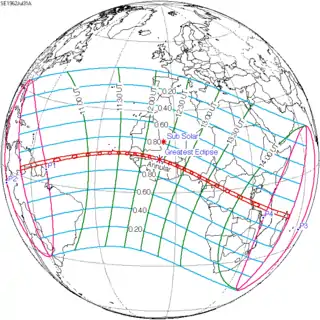 July 31, 1962 (Saros 135) |
 July 11, 1991 (Saros 136) |
 June 21, 2020 (Saros 137) |
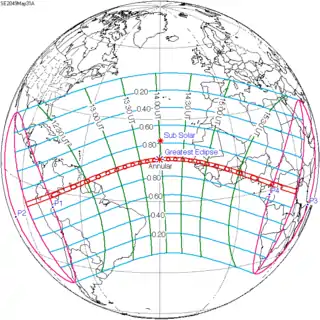 May 31, 2049 (Saros 138) |
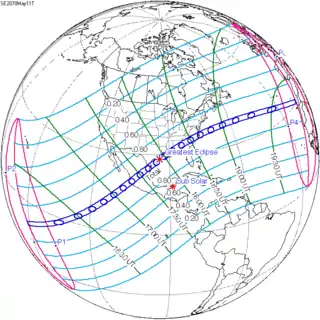 May 11, 2078 (Saros 139) |
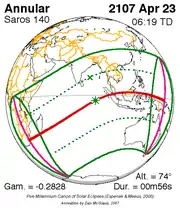 April 23, 2107 (Saros 140) |
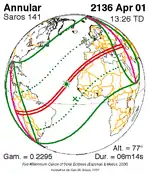 April 1, 2136 (Saros 141) |
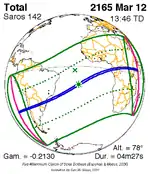 March 12, 2165 (Saros 142) |
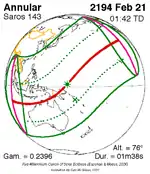 February 21, 2194 (Saros 143) |
|
In the 23rd century:
- Solar Saros 144: Annular Solar Eclipse of 2223 Feb 01
- Solar Saros 145: Total Solar Eclipse of 2252 Jan 12
- Solar Saros 146: Annular Solar Eclipse of 2280 Dec 22
Tritos series
This eclipse is a part of a tritos cycle, repeating at alternating nodes every 135 synodic months (≈ 3986.63 days, or 11 years minus 1 month). Their appearance and longitude are irregular due to a lack of synchronization with the anomalistic month (period of perigee), but groupings of 3 tritos cycles (≈ 33 years minus 3 months) come close (≈ 434.044 anomalistic months), so eclipses are similar in these groupings.
| Series members between 1801 and 2100 | |||
|---|---|---|---|
 December 21, 1805 (Saros 119) |
 November 19, 1816 (Saros 120) |
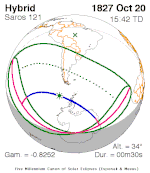 October 20, 1827 (Saros 121) | |
 September 18, 1838 (Saros 122) |
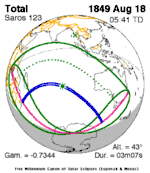 August 18, 1849 (Saros 123) |
 July 18, 1860 (Saros 124) | |
 June 18, 1871 (Saros 125) |
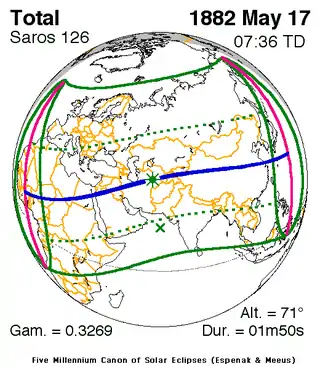 May 17, 1882 (Saros 126) |
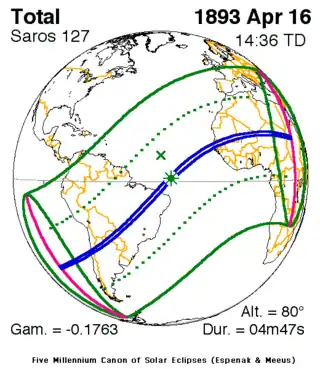 April 16, 1893 (Saros 127) | |
 March 17, 1904 (Saros 128) |
 February 14, 1915 (Saros 129) |
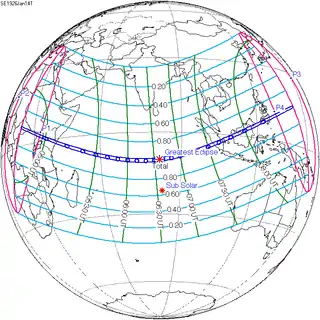 January 14, 1926 (Saros 130) | |
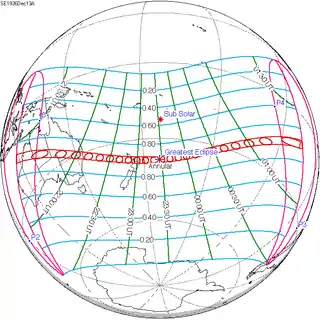 December 13, 1936 (Saros 131) |
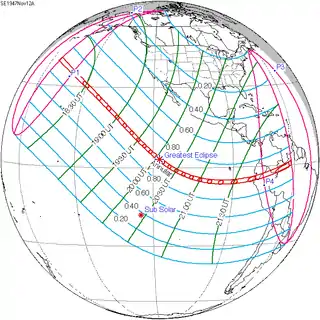 November 12, 1947 (Saros 132) |
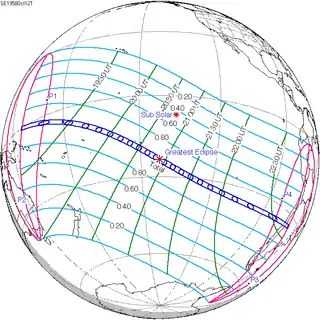 October 12, 1958 (Saros 133) | |
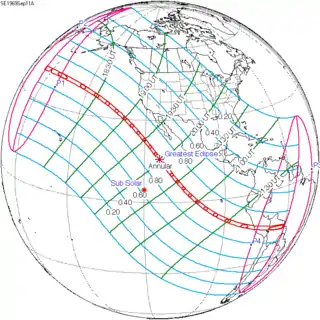 September 11, 1969 (Saros 134) |
 August 10, 1980 (Saros 135) |
 July 11, 1991 (Saros 136) | |
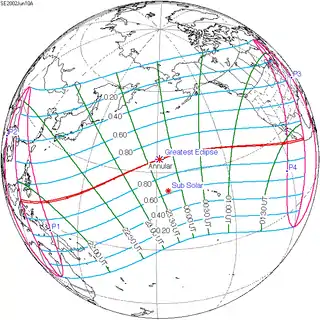 June 10, 2002 (Saros 137) |
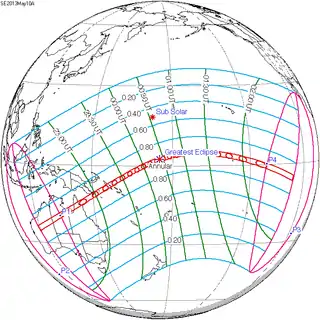 May 10, 2013 (Saros 138) |
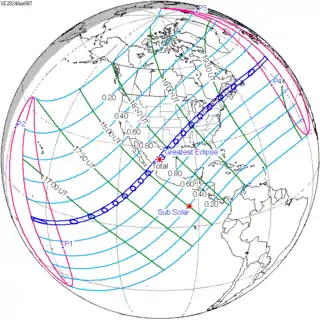 April 8, 2024 (Saros 139) | |
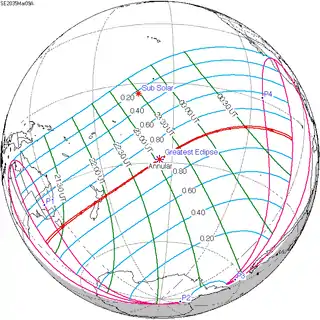 March 9, 2035 (Saros 140) |
 February 5, 2046 (Saros 141) |
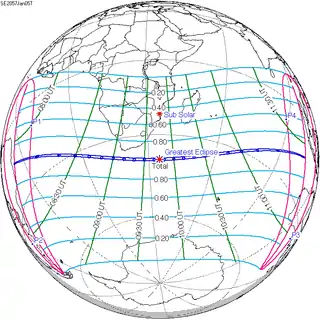 January 5, 2057 (Saros 142) | |
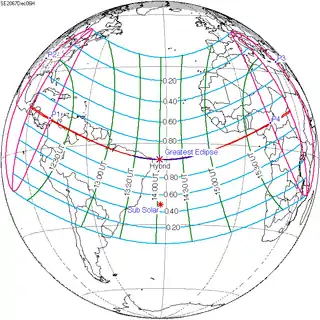 December 6, 2067 (Saros 143) |
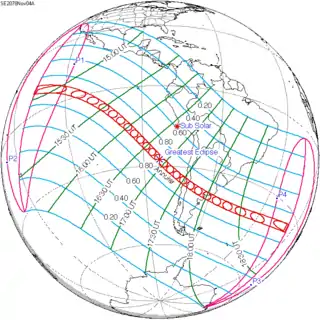 November 4, 2078 (Saros 144) |
 October 4, 2089 (Saros 145) | |
 September 4, 2100 (Saros 146) |
|||
In the 22nd century:
- Solar Saros 147: Annular Solar Eclipse of 2111 Aug 04
- Solar Saros 148: Total Solar Eclipse of 2122 Jul 04
- Solar Saros 149: Total Solar Eclipse of 2133 Jun 03
- Solar Saros 150: Annular Solar Eclipse of 2144 May 03
- Solar Saros 151: Annular Solar Eclipse of 2155 Apr 02
- Solar Saros 152: Total Solar Eclipse of 2166 Mar 02
- Solar Saros 153: Annular Solar Eclipse of 2177 Jan 29
- Solar Saros 154: Annular Solar Eclipse of 2187 Dec 29
- Solar Saros 155: Total Solar Eclipse of 2198 Nov 28
In the 23rd century:
- Solar Saros 156: Annular Solar Eclipse of 2209 Oct 29
- Solar Saros 157: Annular Solar Eclipse of 2220 Sep 27
- Solar Saros 158: Total Solar Eclipse of 2231 Aug 28
- Solar Saros 159: Partial Solar Eclipse of 2242 Jul 28
- Solar Saros 160: Partial Solar Eclipse of 2253 Jun 26
- Solar Saros 161: Partial Solar Eclipse of 2264 May 26
- Solar Saros 162: Partial Solar Eclipse of 2275 Apr 26
- Solar Saros 163: Partial Solar Eclipse of 2286 Mar 25
- Solar Saros 164: Partial Solar Eclipse of 2297 Feb 22
Metonic series
The metonic series repeats eclipses every 19 years (6939.69 days), lasting about 5 cycles. Eclipses occur in nearly the same calendar date. In addition, the octon subseries repeats 1/5 of that or every 3.8 years (1387.94 days). All eclipses in this table occur at the Moon's descending node.
| 21 eclipse events, progressing from north to south between July 11, 1953 and July 11, 2029 | ||||
|---|---|---|---|---|
| July 10–12 | April 29–30 | February 15–16 | December 4–5 | September 21–23 |
| 96 | 98 | 100 | 102 | 104 |
| July 12, 1915 | April 30, 1919 | February 15, 1923 | December 5, 1926 | September 22, 1930 |
| 106 | 108 | 110 | 112 | 114 |
| July 11, 1934 | April 30, 1938 | February 15, 1942 | December 4, 1945 | September 22, 1949 |
| 116 | 118 | 120 | 122 | 124 |
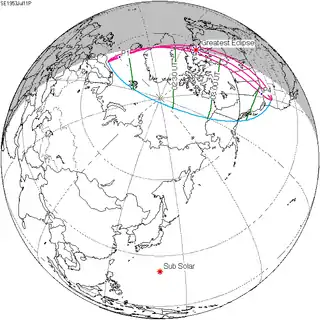 July 11, 1953 |
 April 30, 1957 |
 February 15, 1961 |
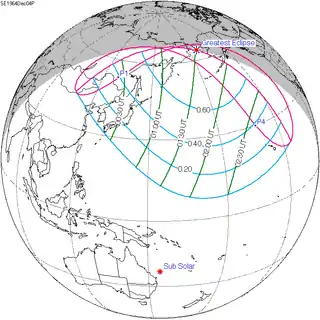 December 4, 1964 |
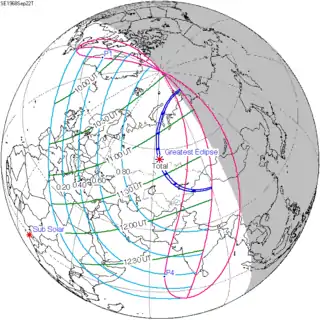 September 22, 1968 |
| 126 | 128 | 130 | 132 | 134 |
 July 10, 1972 |
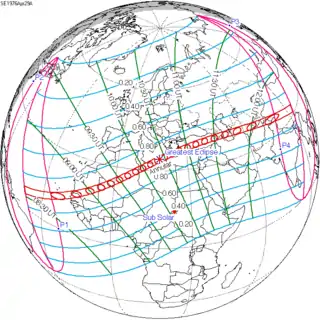 April 29, 1976 |
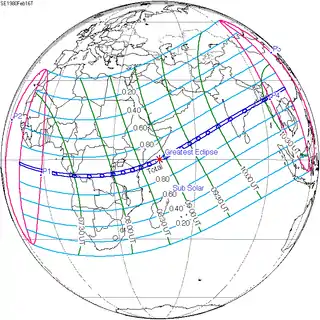 February 16, 1980 |
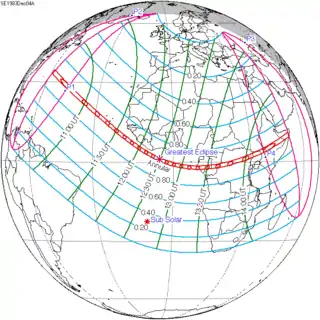 December 4, 1983 |
 September 23, 1987 |
| 136 | 138 | 140 | 142 | 144 |
 July 11, 1991 |
 April 29, 1995 |
 February 16, 1999 |
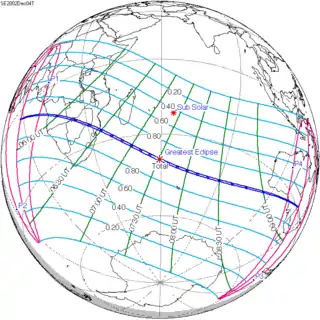 December 4, 2002 |
 September 22, 2006 |
| 146 | 148 | 150 | 152 | 154 |
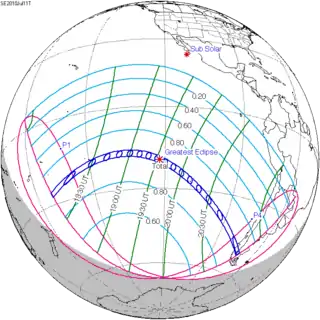 July 11, 2010 |
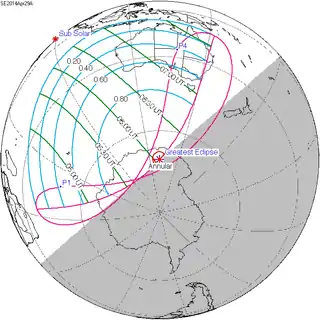 April 29, 2014 |
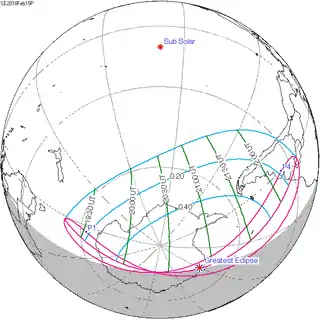 February 15, 2018 |
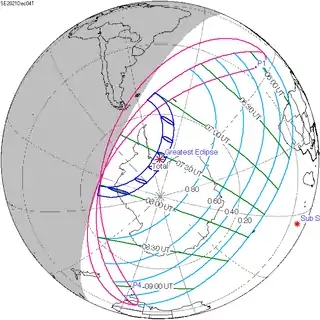 December 4, 2021 |
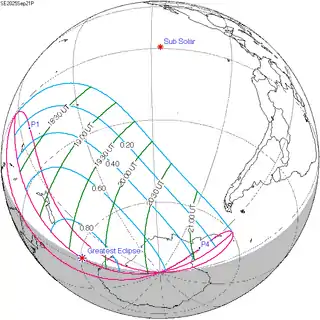 September 21, 2025 |
| 156 | 158 | 160 | 162 | 164 |
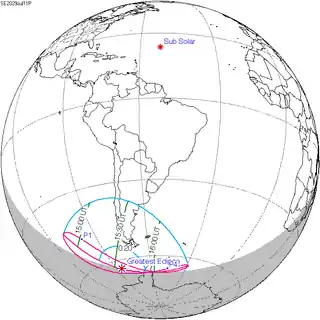 July 11, 2029 |
April 29, 2033 | February 15, 2037 | December 4, 2040 | September 21, 2044 |
Notes
- van Gent, R.H. "Solar- and Lunar-Eclipse Predictions from Antiquity to the Present". A Catalogue of Eclipse Cycles. Utrecht University. Retrieved 6 October 2018.
- SEsaros136 at NASA.gov
References
- NASA graphics
- Observer's handbook 1991, Editor Roy L. Bishop, The Royal Astronomical Society of Canada (p. 101)
Photos:
- Russian scientist observed eclipse
- Russia expedition
- Baja California, La Paz. Prof. Druckmüller's eclipse photography site
- Baja California, Todos Santos. Prof. Druckmüller's eclipse photography site
- Reyna from La Paz, Baja California, Mexico
- www.noao.edu: Satellite view of eclipse
- APOD 7/16/1999, Solar Surfin', total eclipse corona, from Mauna Kea, Hawaii
- APOD 10/24/1995, A Total Solar Eclipse, total eclipse corona
- The 1991 Eclipse in Mexico
Videos:
- Total Solar Eclipse -- July 11, 1991 (9:39 uncut, eclipse full frame, location insert)
- Total Solar Eclipse (8:23 edited, includes pre-planning and post-press, music only)
- Total Solar Eclipse, Cabo Mexico (9:12 edited, includes some TV news coverage)
| Wikimedia Commons has media related to Solar eclipse of 1991 July 11. |
.jpg.webp)

